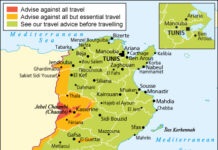As monkeypox cases mount and the disease spreads, some people might have déjà vu — here comes another potentially life-disrupting virus. Although monkeypox first surfaced more than six decades ago, public health officials say this outbreak is different.
The disease was first discovered in monkeys kept for research at the Statens Serum Institut in Copenhagen, Denmark, in 1958. The first human case was reported in 1970 in the Democratic Republic of Congo.
As The Washington Post reported, the monkeypox virus is from the Orthopoxvirus genus, which includes the variola virus that causes smallpox. Monkeypox is zoonotic, meaning it spreads from animals to humans.
Although monkeypox and smallpox have similar symptoms, monkeypox is generally milder and much less likely to cause death, Healthline reported.
Historically, monkeypox outbreaks have been largely centralized in or connected to central or west African countries, where the disease is endemic. Before the current outbreak, “almost all monkeypox cases in people outside of Africa were linked to international travel to countries where the disease commonly occurs or through imported animals,” according to the Centers for Disease Control and Prevention.
Human-to-human monkeypox transmission has now been reported in more than 70 countries; since May 17, more than 6,600 monkeypox cases have been identified in the United States. On Aug. 4, the Biden administration declared monkeypox a public health emergency, a move that can increase funding for health agencies responding to the outbreak and accelerate vaccine distribution.
These unprecedented case counts and the fact that monkeypox has been spreading largely among men who have sex with men has made the current outbreak unique — and increased international attention to the virus.
Here’s what we know.
Monkeypox spreads through close contact, according to the CDC. This includes direct contact with monkeypox rash, scabs or bodily fluids from someone infected with the virus; touching objects, fabrics and surfaces that someone with monkeypox has used; and contact with respiratory secretions from someone who is infected.
Someone who is pregnant can spread the virus to the fetus through the placenta. People can also get monkeypox from infected animals.
“In short, it’s a virus,” said Andy Seale, an adviser with the WHO and an expert on global HIV, hepatitis and sexually transmitted infections. “Viruses can affect anybody,” he said, and are often spread in more than one way.
Seale added that current monkeypox cases seem to be “most efficiently transmitted through sexual contact.” Because the virus “found its way into networks” of men who have sex with other men, those men are the most affected. (The sexual networks of men who have sex with men includes people who identify as gay, bisexual, pansexual, transgender and nonbinary.)

People line up at a monkeypox vaccination site on July 28, 2022, in Encino, Calif. California’s public health officer said they are pressing for more vaccine and closely monitoring the spread of the monkeypox virus. (AP)
People with monkeypox can “have lesions that are hidden inside the mouth or inside and around their genitals,” Seale said. “These might not be so obvious.”
Contact with those lesions, which can occur when people are kissing or engaging in other forms of close intimate contact, will spread monkeypox, he said.
Monkeypox can be transmitted via “respiratory secretions,” according to the CDC, but that isn’t the same as COVID-19-style airborne transmission of the virus.
“Airborne transmission occurs when small virus particles become suspended in the air and can stay there for periods of time,” the CDC said. “These particles can spread on air currents, or sometimes even infect people who enter a room after the infected person has left. In contrast, monkeypox may be found in droplets like saliva or respiratory secretions that drop out of the air quickly.”
As of June 9, long-range airborne transmission of monkeypox had not been reported, the CDC said. It added that monkeypox wouldn’t spread during casual conversations. Walking by someone with monkeypox in a store, for example, would not transfer the virus, but sharing a bed with someone who is infected might.
Scientists are still researching whether the virus can be spread by asymptomatic people; whether monkeypox can be spread through semen, vaginal fluids, urine or feces; and just how often monkeypox is spread through respiratory secretions, the CDC reported.
Available data shows that the majority of people who have had monkeypox since the outbreak started are men who report having sex with men:
- A BMJ study published in July said 96% of the 1,735 people who had contracted monkeypox in the U.K. as of July 12 were gay, bisexual or other men who have sex with men.
- Analysis of 528 monkeypox infections diagnosed in 16 countries from April to June 2022 found that 98% of the people infected were gay or bisexual men, according to a New England Journal of Medicine study.
- Of 1,383 patients in the U.S. where information on sex assigned at birth was available, about 99.1% of monkeypox cases were reported in male patients as of July 25, 2022, CDC data shows. Of patients who provided sexual activity information, 99% — or 624 people — “reported male to male sexual contact.”
Some have questioned whether monkeypox testing and data collection might be biased in such a way that men who have sex with men might be overrepresented, but many researchers now say that cannot explain such a consistent pattern.
“Although some monkeypox patients have mild infections that may be missed or misdiagnosed, others have very characteristic rashes and agonizing pains that require hospitalization for pain treatment,” Science Magazine reported. “If many people outside the MSM (men who have sex with men) community had monkeypox, more would have shown up in the statistics by now.”
Monkeypox is not exclusively spread during sexual intimacy. It can also spread in household settings, said Dr. Rosamund Lewis, the WHO’s technical lead for monkeypox. At least four children in the U.S. have tested positive for monkeypox as of Aug. 1.
As pediatric cases have appeared, some people have tried linking them to men who have sex with men. On Twitter, for example, Rep. Marjorie Taylor Greene, R-Ga., asked, “If Monkeypox is a sexually transmitted disease, why are kids getting it?”
The CDC’s monkeypox FAQ page contradicts Greene’s suggestion, saying that monkeypox “is not considered a sexually transmitted infection.”
On July 25, far-right radio host Stew Peters said, “So far, basically all cases of monkeypox have spread as an STD through gay sex, so does anyone want to guess what might have happened for these kids to get it?”
The insinuation that the children who caught monkeypox were molested is linked to longstanding false claims that gay, lesbian and bisexual men molest children at higher rates than non-LGBTQ people. And the WHO’s Seale said Aug. 2 that health officials have seen monkeypox cases in women and children that are most likely linked to household contact during this outbreak.
“If one person in the household becomes infected, it can be quite easy for that then to transmit to others in the same household again through just the close physical contact that comes with being in a close family — nothing to do with sex,” Seale said.
RELATED: There’s no evidence that the virus behind the monkeypox outbreak was leaked from a Wuhan lab
This article was originally published by PolitiFact, which is part of the Poynter Institute. It is republished here with permission. See the sources for these fact checks here and more of their fact checks here.








